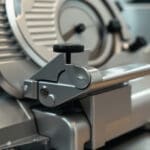Agricultural equipment is a vital part of any farming operation, playing a crucial role in enhancing productivity and efficiency. Farmers rely on a diverse range of machines such as tractors for pulling various implements, combines for harvesting, and specialized attachments for performing tasks like plowing and seed spreading. Understanding the right agricultural equipment for your field can drastically improve operational efficiency.
- Tractors: versatile machines for pulling and towing
- Combines: used in harvesting crops efficiently
- Attachments: improve tractors’ functionality for varied tasks
As agriculture advances, adopting the right machinery is more important than ever. Advanced agricultural equipment not only boosts productivity but also aligns with sustainable practices.
I’m Todd Cleppe. For over 25 years, my focus on agricultural equipment at CFAB Global influenced better machinery design and efficiency across industries. Let’s explore how CFAB Global’s offerings can drive your farm’s success with cutting-edge solutions.

Agricultural equipment terms made easy:
– farm implements
– farm machinery parts
– farm and tractor supply
Types of Agricultural Equipment
Tractors
Tractors are the backbone of any farm, offering best versatility and power. They come in various types to suit different farming needs:
-
Compact Tractors: These are small yet powerful, perfect for tasks in tight spaces. They handle basic farm functions, making them ideal for small to mid-sized farms.
-
Wheeled Tractors: Known for their adaptability, wheeled tractors can be used for a wide range of tasks, from tilling to hauling. Their versatility makes them a staple in many farming operations.
-
Track Tractors: Equipped with tracks instead of wheels, these tractors offer better traction and a smoother ride, especially on uneven terrain. They are excellent for heavy-duty tasks like plowing large fields.
-
Specialty Crop Tractors: Designed for orchards and vineyards, these narrow tractors can maneuver between rows of crops, ensuring efficient maintenance and harvesting.
Tractors can be fitted with numerous attachments to increase their functionality, allowing farmers to perform tasks such as plowing, seeding, and fertilizing with ease.
Combines and Forage Harvesters
Combines are essential for harvesting crops efficiently, combining three processes: reaping, threshing, and winnowing. They are commonly used for grains like wheat and corn but can adapt to other crops as well.
- Reaping: The cutting of grain crops.
- Threshing: Separating the grain from the chaff.
- Winnowing: Removing the lighter chaff from the grain.
Even smaller farms can benefit from using combines or forage harvesters, which help in turning cereal crops into grain efficiently. In regions like Northern California and Oregon, combines are frequently used for rice and grass seed.

ATVs, RTVs, and UTVs
All-terrain vehicles (ATVs), recreational terrain vehicles (RTVs), and utility task vehicles (UTVs) are becoming increasingly popular on farms for their versatility and mobility.
-
ATVs and UTVs: These vehicles are ideal for transporting supplies and equipment across the farm quickly. They can steer rough terrains and are often used for tasks like checking livestock or fences.
-
Attachments: Like tractors, ATVs and UTVs can be equipped with various attachments, such as sprayers and small trailers, to improve their utility on the farm.
These vehicles are essential for improving efficiency and reducing the time spent on routine tasks, making them a valuable addition to any farm’s agricultural equipment lineup.
As agricultural equipment continues to evolve, adopting the right machinery can significantly improve farm productivity and sustainability.
Essential Tractor Attachments
Tractor attachments are vital for maximizing the utility of your agricultural equipment. These attachments transform tractors into multifunctional tools, allowing farmers to tackle various tasks efficiently. Let’s explore some essential tractor attachments and their types.
Plows
Plows are the first step in soil preparation. They break up and turn over the soil, making it ready for planting. There are several types of plows, each suited for different soil conditions:
-
Moldboard Plows: These have wing-shaped blades that cut into and turn the soil. Ideal for shallow but thorough soil turning, they are often used on land that hasn’t been cultivated for years.
-
Disc Plows: Equipped with rows of discs, these plows are effective in cutting up weeds and handling sticky or rocky soil. They’re less common but useful for certain conditions.
-
Chisel Plows: Known for their long shanks, these plows turn soil at depths of a foot or more, which is necessary for land used in continuous crop production.
Harrows
After plowing, harrows are used to further break down the soil and make it level. They also help distribute crop residue and fertilizer evenly. Types of harrows include:
-
Spring Harrows: Although less common today, these use flexible iron teeth to loosen the soil.
-
Roller Harrows: Featuring large spiked tubes, they crush the soil to prepare it for planting.
-
Chain Harrows: Resembling chain nets with spikes, they aerate and distribute soil and fertilizer.
-
Disc Harrows: These modern harrows use rows of discs to break up soil and weeds more thoroughly.
Fertilizer Spreaders
Fertilizer spreaders are crucial for distributing nutrients evenly across fields, boosting crop growth. The main types are:
-
Broadcast Spreaders: These spread fertilizer over a wide area and are suitable for large fields.
-
Manure Spreaders: Designed to distribute manure, they help recycle farm waste into valuable nutrients.
-
Slurry Spreaders: These handle liquid fertilizers, ensuring even application over the soil.
Seeders
Seeders are used to plant seeds efficiently, and their precision can affect crop yield. Different types of seeders include:
-
Broadcast Seeders: Also known as rotary spreaders, they are effective for planting cover crops and grasses.
-
Air Seeders: Using compressed air, they shoot small, round seeds into the ground, ideal for specific seed types.
-
Box Drill Seeders: These drill into the soil and drop seeds at a specific depth, working well with various seed types.
-
Planters: Known for precision, they cut into the ground, drop individual seeds, and close the soil behind them, making them the most accurate but also the most expensive option.
Balers
Balers are essential for collecting hay, straw, and corn stalks. They wrap these materials into manageable bales. Types of balers include:
-
Round Balers: These roll hay into round shapes, then wrap them in twine or netting.
-
Square Balers: They compress hay into square shapes, tying them with twine or wire. They come in various sizes to suit different needs.
-
Large Square Balers: Designed for industrial farms, they handle larger volumes, unlike their smaller counterparts.
Each attachment improves the functionality of tractors, making them indispensable in modern farming. By choosing the right attachments, farmers can improve efficiency, reduce labor, and optimize their agricultural operations.
Modern Trends in Agricultural Equipment
The world of agricultural equipment is rapidly evolving, thanks to advancements in automation, technology, and data tracking. These trends are changing how farmers operate, making agriculture more efficient and sustainable.
Automation
Automation is becoming a game-changer in agriculture. Automated equipment, such as autonomous tractors and precision sprayers, allows farmers to perform tasks with minimal human intervention. This technology not only reduces labor costs but also improves productivity by operating continuously and accurately. For example, automated sprayers can target specific areas of a field, reducing pesticide and fertilizer use, which aligns with global sustainability goals like the European Green Deal’s pesticide reduction target.
Technology
The integration of technology in farm machinery is paving the way for smarter farming. Modern tractors and combines are equipped with GPS, sensors, and cameras that provide real-time data. This data helps farmers make informed decisions about planting, watering, and harvesting. Moreover, software solutions like farm management systems enable farmers to monitor their operations from anywhere, optimizing resource use and improving yield.
Data Tracking
Data tracking is another crucial trend in modern agriculture. By collecting and analyzing data, farmers can track everything from soil health to crop growth. This data-driven approach allows for precise farming practices, leading to better crop management and increased efficiency. For instance, using data from automated equipment, farmers can keep detailed records for compliance with sustainability programs and certifications.
These trends in agricultural equipment are not just about improving efficiency; they are about creating a more sustainable and productive agricultural sector. As technology continues to advance, the possibilities for innovation in farming are endless, driving the industry forward into a new era.
Frequently Asked Questions about Agricultural Equipment
What equipment is used for agriculture?
Agriculture relies heavily on a diverse range of machinery to perform various tasks efficiently. Tractors are the backbone of farm operations, pulling everything from plows to seeders. Plows are used to prepare the soil by turning it over, making it ready for planting. Seeders ensure that seeds are distributed evenly across the field, optimizing growth conditions. Balers compress cut crops into compact bales for easy handling, storage, and transport. Wagons are essential for moving harvested crops and materials around the farm. Each piece of equipment plays a crucial role in the cycle of planting and harvesting, contributing to the farm’s overall productivity.
What is considered agricultural machinery?
Agricultural machinery encompasses any machine used in the farming process. This includes everything from large, complex machines like combines and tractors to smaller equipment like fertilizer spreaders and balers. These machines are designed to handle various tasks such as planting, cultivating, and harvesting crops. The use of machinery in agriculture has significantly increased efficiency and reduced the need for manual labor, allowing farmers to cover larger areas and produce more food.
What are 5 tools farmers use?
Farmers use a variety of tools to ensure efficient farm operations. Here are five essential ones:
-
Plows – These are used to turn and aerate the soil, preparing it for planting.
-
Harrows – Following plowing, harrows break up clumps of soil and even out the surface, creating a suitable seedbed.
-
Fertilizer Spreaders – These machines evenly distribute fertilizers across the field, promoting healthy crop growth.
-
Seeders – Seeders plant seeds at the right depth and spacing, ensuring optimal conditions for germination.
-
Balers – Used to compress and bind harvested crops like hay or straw into bales for easy handling and storage.
Each of these tools is vital in supporting the various stages of crop production, from soil preparation to harvest.
Conclusion
At CFAB Global, we understand that operational efficiency is key to successful farming. Our commitment to enhancing the performance and reliability of agricultural equipment is evident through our exclusive Machine Reliability Program. This program is designed to optimize the functionality and longevity of your machinery, ensuring you get the most out of your investment.
Our Machine Reliability Program offers a custom approach to machinery maintenance and support. We don’t believe in a one-size-fits-all solution. Instead, we customize our services to meet the specific needs of your farming operations. From initial consultation to ongoing support, our team of experts is with you every step of the way. This personalized attention helps prevent costly downtime and maximizes productivity.
By focusing on predictive maintenance, we help you avoid unexpected breakdowns. Our strategies are designed to keep your equipment running smoothly, so you can focus on what you do best—farming. With CFAB Global as your partner, you can trust that your machinery will operate at peak performance, contributing to your farm’s overall success.
For more information on how CFAB Global can support your agricultural machinery needs, visit our agricultural machinery parts page. Find how our solutions can drive your farm’s productivity and efficiency forward.






